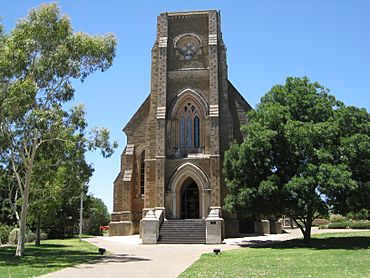Sevenhill, South Australia facts for kids
Quick facts for kids SevenhillSouth Australia |
|||||||||||||||
|---|---|---|---|---|---|---|---|---|---|---|---|---|---|---|---|

St Aloysius Church, Sevenhill
|
|||||||||||||||
| Established | 1850 | ||||||||||||||
| Postcode(s) | 5453 | ||||||||||||||
| Location | |||||||||||||||
| LGA(s) | District Council of Clare and Gilbert Valleys | ||||||||||||||
| Region | Mid North | ||||||||||||||
| State electorate(s) | Frome | ||||||||||||||
| Federal Division(s) | Grey | ||||||||||||||
|
|||||||||||||||
Sevenhill is a small town in the Clare Valley region of South Australia. It's about 130 kilometers (80 miles) north of Adelaide. The town was started in 1850 by members of the Jesuit order, a group of Catholic priests. Its name was chosen by an Austrian Jesuit priest, Aloysius Kranewitter. He named it after the seven hills of Rome, a famous city in Italy.
Contents
History of Sevenhill
The first Jesuit priests in the area arrived in Clare in 1848. They were asked by Catholic people from Tanunda to create a Catholic settlement. These people felt more comfortable living with others who shared their faith. So, the Jesuits began looking for a good place in the Clare district.
Founding the Town
In 1850, a man named Thomas Burr bought a piece of land. He was a former Deputy Surveyor General of South Australia. Jesuit priest Aloysius Kranewitter really liked this land because it was hilly and fertile. Because of his influence, Burr divided the land into smaller blocks. These blocks were then leased out, and this became the town of Sevenhill.
In December 1850, Kranewitter and Burr decided on the layout of the new settlement. By January 1851, Kranewitter was already calling the future site Sevenhill Township. The first land leases were available in April 1851. Many Catholic families, especially Irish, Polish, and German, moved there. They came from places like Kapunda, Tanunda, and Burra.
The Name Debate
For a while, especially in the 1930s and 1940s, people weren't sure if the town's name was Sevenhill or Sevenhills. This caused some debate. A stamp collector from Clare, Albert Fryar, found clear proof. He showed old envelopes and postal stamps that proved the original name was indeed Sevenhill.
Saint Aloysius Church and College
In 1851, around the same time the town was founded, the Jesuits built the Saint Aloysius Church. They also started the Sevenhill Winery about one kilometer east of the town. A local settler, Francis Weikert, gave the land for these buildings. He is buried in the Sevenhill cemetery.
Vineyard and Winery Beginnings
In September 1851, Brother Schreiner brought some young grapevines from Bungaree Station. This was the start of the Sevenhill vineyard. This led to a very successful wine industry in the area.
Saint Aloysius' College
In 1856, Saint Aloysius' College was opened. By 1866, the college had impressive buildings and large grounds. These grounds included playing fields. The college was well-known across Australia. At that time, it was the only Roman Catholic school in South Australia. Students came from many other parts of Australia. The college operated until 1886. By then, more Catholic schools were available elsewhere.
Besides offering regular education for students of all faiths, the college also had a seminary. A seminary is a place that trains young men to become priests in the Catholic Church. This training continued even after the college closed. Fr. Julian Tenison-Woods, a very famous priest, prepared for his ordination there in 1856.
Railway History
A railway line was built from Riverton to Clare in 1919. It was extended to Spalding in 1922. The railway track between Sevenhill and Penwortham was damaged by the Ash Wednesday bushfires. This damage led to the railway's closure. It officially closed in April 1984, and the tracks were removed in 1989. However, the old railway path is now used as the Riesling Trail. This is a popular path for cycling and walking.
Sevenhill Today
The nearby town of Clare provides many of the shops and services for the Sevenhill area. Clare is also a center for government offices. Sevenhill itself has a hotel and a special shop that sells wines from many local wineries. There is also a gourmet bakery, which is the only bakery in the region. You can find a homewares shop, several bed and breakfast places, and an antique shop. The town also has a Country Fire Service station.
The community hall is used for weekend markets. Friday night bingo is a long-standing tradition there. Many of the region's famous wineries are located near Sevenhill. Pikes Winery is right next to the old St Aloysius' college.
The town's oval is east of the main cross road and has toilets. A cricket team plays there in the summer. There are also tennis courts available. Sevenhill is considered the "heart" of the Clare Valley. It's a great place for locals and tourists. It offers easy access to the Riesling Trail walking and cycling path, with parking available.
Geography and Climate
Sevenhill is located in a hilly area at the start of the Hutt River. The town itself sits on a small flat plain. However, around Sevenhill, especially to the east and west, are rugged ranges. Some of these ranges are covered in scrub. The area is mainly used for farming. This includes grazing animals, growing crops, and vineyards. The town has a small population and is on a part of the Main North Road called the Horrocks Highway.
Governance
Sevenhill is managed by the District Council of Clare and Gilbert Valleys at the local level. For state elections, Sevenhill is part of the Frome district. For federal elections, it is in the Grey division.


